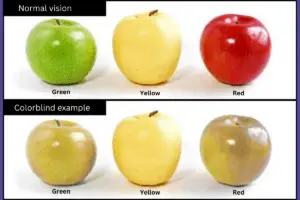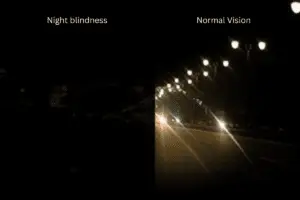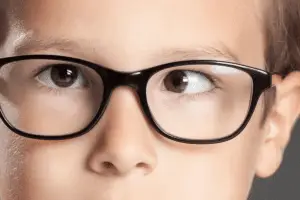Common defects of vision and their corrections

Good vision is a key part of living a full, independent life. However, millions of people around the world struggle with vision problems, often without knowing the exact cause or solution. The good news is that most common vision defects are treatable or correctable with modern medical advancements.
In this guide, we’ll explore the 8 most common eye defects, what causes them, how they affect your vision, and the options available to correct or manage them.
- Myopia (Nearsightedness)
- Hyperopia (Farsightedness)
- Astigmatism
- Presbyopia (Age-related focusing loss)
- Color blindness (Color vision deficiency)
- Night blindness (Nyctalopia)
- Amblyopia (Lazy Eye)
- Strabismus (Crossed or Misaligned Eyes)
1. Myopia (Nearsightedness)

Myopia is a condition where you can see close objects clearly, but distant objects appear blurry. It occurs when the eyeball is too long, or the cornea has too much curvature, causing light to focus in front of the retina instead of directly on it.
Symptoms:
- Blurry distance vision.
- Squinting to see clearly.
- Eye strain or fatigue.
- Headaches
Causes:
- Genetic predisposition (runs in families).
- Excessive near work (reading, screen time).
- Environmental factors during childhood.
Correction:
- Eyeglasses with concave lenses (minus-powered lenses).
- Contact lenses for a wider field of view.
- Laser surgery (LASIK, SMILE) to reshape the cornea.
- Orthokeratology (Ortho-K) – specially designed overnight lenses to reshape the eye temporarily.
2. Hyperopia (Farsightedness)

Hyperopia is the opposite of myopia—distant objects are seen clearly, but close-up tasks like reading or sewing become difficult. It occurs when the eyeball is too short, or the cornea is too flat, causing light to focus behind the retina.
Symptoms:
- Eye strain when reading or using a phone.
- Blurry near vision.
- Frequent headaches.
- Discomfort after prolonged near work.
Causes:
- Often hereditary.
- Can be present from birth.
Correction:
- Eyeglasses with convex lenses (plus-powered lenses).
- Contact lenses
- Refractive surgeries like LASIK or LASEK for permanent correction.
3. Astigmatism

Astigmatism occurs when the cornea or lens has an irregular shape—more like a football than a basketball. This leads to blurred or distorted vision at all distances because light rays are not evenly focused on the retina.
Symptoms:
- Blurry or distorted vision.
- Trouble seeing at night.
- Headaches
- Eyestrain
- Squinting
Causes:
- Usually present from birth.
- Can develop after an eye injury or surgery.
- Often occurs with myopia or hyperopia.
Correction:
- Glasses with cylindrical correction.
- Toric contact lenses specially designed for astigmatism.
- Laser surgery like topography-guided LASIK or PRK.
4. Presbyopia (Age-related focusing loss)

Presbyopia is a natural, age-related condition where the eye gradually loses the ability to focus on close objects. It typically begins after age 40 and affects nearly everyone to some extent.
Symptoms:
- Holding reading material farther away.
- Eye fatigue while reading.
- Needing brighter light to see clearly.
- Blurred near vision.
Causes:
- Aging of the eye’s natural lens, which becomes less flexible over time.
Correction:
- Reading glasses
- Bifocals or progressive lenses.
- Multifocal contact lenses.
- Surgical options like PresbyLASIK, corneal inlays, or lens replacement.
5. Color blindness (Color vision deficiency)

Color blindness is the inability to distinguish between certain colors, most commonly red and green. It affects more men than women and is usually inherited.
Symptoms:
- Difficulty telling colors apart.
- Learning difficulties in children due to misinterpreting colored charts or visuals.
- Problems with color-coded tasks (e.g., traffic signals).
Causes:
- Genetic mutations affecting photopigments in the retina.
- Eye diseases, certain medications, or aging in rare cases.
Correction:
- No cure for inherited color blindness.
- Color-corrective lenses can help some individuals.
- Mobile apps or digital tools assist with color interpretation.
6. Night blindness (Nyctalopia)

Night blindness is a condition where vision becomes poor in dim lighting or darkness. It’s a symptom rather than a disease and can indicate underlying eye issues.
Symptoms:
- Difficulty driving or walking in low light.
- Poor adaptation from light to dark environments.
- Needing more time to adjust in dark rooms.
Causes:
- Vitamin A deficiency
- Cataracts
- Retinitis pigmentosa (a rare inherited disease).
- Diabetes-related complications.
Correction:
- Addressing the underlying cause (e.g., cataract surgery, Vitamin A supplements).
- Night vision aids.
- Regular eye exams for early detection of serious diseases.
7. Amblyopia (Lazy Eye)

Amblyopia occurs when one eye fails to develop normal vision during early childhood. The brain starts favoring the stronger eye, and the weaker one becomes “lazy.”
Symptoms:
- Poor depth perception.
- Squinting or closing one eye.
- One eye turning inward or outward.
- Blurry vision in one eye.
Causes:
- Strabismus (misaligned eyes).
- Unequal refractive errors.
- Obstruction in vision (e.g., cataract in one eye).
Correction:
- Eye patching the stronger eye to encourage use of the weaker one.
- Vision therapy
- Corrective lenses
- Surgery if caused by cataracts or strabismus.
8. Strabismus (Crossed or Misaligned eyes)

Strabismus is when both eyes do not align in the same direction. One eye may turn in, out, up, or down while the other focuses correctly.
Symptoms:
- Eyes pointing in different directions.
- Double vision
- Eye strain
- Poor depth perception.
Causes:
- Weak eye muscles.
- Poor communication between the brain and eye muscles.
- Stroke or head injury in adults.
- Often present from birth.
Correction:
- Glasses or prism lenses.
- Vision therapy
- Surgery to realign eye muscles if needed.
When to get your eyes checked?
Even if you have no symptoms, a regular eye exam is essential—especially after age 40. Visit an eye specialist if you notice:
- Blurred vision (near or far).
- Difficulty seeing at night.
- Headaches or tired eyes.
- Color confusion.
- Changes in visual clarity.
Early diagnosis often means simpler, more effective treatments.
Conclusion
Most vision defects are not only manageable but treatable. From simple glasses to advanced surgeries, modern eye care offers solutions for nearly every common defect. If you or your loved ones are experiencing vision problems, don’t ignore them. Timely treatment can prevent further complications and help you regain clear sight.
At Krisha Eye Hospital, we offer advanced diagnostics, experienced ophthalmologists, and personalized treatment plans for every kind of vision problem.
Book your appointment today and take the first step toward clearer, healthier vision.
Author bio
Dr. Dhwani Maheshwari, an esteemed ophthalmologist with over 10 years of experience, leads Krisha Eye hospital in Ahmedabad with a commitment to advanced, patient-centered eye care. Specializing in cataract and refractive surgery, Dr. Maheshwari has performed more than a thousand successful surgeries. Her expertise lies in phacoemulsification, a technique recognized for its precision in cataract treatment.
Dr. Maheshwari’s educational journey includes an MBBS from Smt. NHL MMC, a DOMS from M & J Institute of Ophthalmology, and a DNB in Ophthalmology from Mahatme Eye Bank Eye Hospital, Nagpur. She also completed a fellowship in phacoemulsification at Porecha Blindness Trust Hospital, further enhancing her surgical skills. In addition to her work at Krisha Eye Hospital, Dr. Maheshwari serves as a consultant ophthalmologist at Northstar Diagnostic Centre.
Under her leadership, Krisha Eye Hospital aims to bring all superspecialties under one roof, offering comprehensive eye care solutions for all vision needs.
FAQs
The most common vision defects include myopia (nearsightedness), hyperopia (farsightedness), astigmatism, and presbyopia. Other conditions such as amblyopia (lazy eye), strabismus (crossed eyes), and night blindness are also relatively common and can significantly impact daily life.
Vision defects can be caused by genetic factors, aging, eye shape abnormalities, or underlying medical conditions like diabetes or vitamin deficiencies. Environmental factors like prolonged screen time or poor lighting can also contribute, especially in children and working adults.
Some defects, such as myopia and hyperopia, can be corrected permanently with refractive surgeries like LASIK or SMILE. Others, like presbyopia and color blindness, can be managed but not fully cured. Early detection and treatment improve outcomes significantly.
If you experience blurred vision, frequent headaches, eye strain, or difficulty reading, it’s a good idea to schedule an eye exam. An optometrist will determine the type and degree of refractive error and prescribe suitable corrective lenses.
Some vision issues, like myopia and astigmatism, can appear in childhood or adolescence, while others like presbyopia usually begin after age 40. Regular eye checkups from an early age are essential for timely diagnosis and correction.
Yes, LASIK is a safe and commonly performed procedure for correcting myopia, hyperopia, and astigmatism. However, not everyone is a candidate. A thorough evaluation by an ophthalmologist is necessary to determine suitability.
Yes. Conditions like myopia can progress during teenage years, and presbyopia naturally worsens with age. Regular follow-ups help track these changes and ensure your corrective measures (glasses, lenses, or treatments) remain effective.
Refractive errors (like myopia or astigmatism) are vision problems caused by the shape of the eye, and they can be corrected with glasses, lenses, or surgery. Eye diseases (like glaucoma or cataracts) involve structural or functional damage to the eye and may require medical or surgical treatment.
It’s generally recommended to have an eye exam once every 1–2 years, even if you don’t wear glasses. Children, seniors, and people with existing eye conditions may need more frequent check-ups.
Yes, children can develop myopia, hyperopia, astigmatism, or amblyopia as early as age 3. Watch for signs like squinting, sitting too close to the TV, or frequent eye rubbing. Early detection helps prevent long-term vision problems.
No, not all eye surgeries involve lasers. While procedures like LASIK use lasers, others like cataract removal or vitrectomy may involve traditional surgical instruments or a combination of techniques.
No, astigmatism is not dangerous, but it can cause blurred or distorted vision, eye strain, and headaches if left uncorrected. It’s easily managed with glasses, contact lenses, or refractive surgery.
Not always. Contact lens prescriptions consider additional factors like corneal curvature and lens diameter. A separate fitting is required to ensure optimal vision and comfort.
- Myopia (nearsightedness): You can see nearby objects clearly, but distant objects are blurry.
- Hyperopia (farsightedness): You can see distant objects clearly, but nearby ones appear blurry.
Both are refractive errors but affect the eye in opposite ways.
Prolonged screen time can cause digital eye strain or computer vision syndrome, but it doesn’t directly cause refractive errors. However, it may aggravate existing issues or cause temporary discomfort.
While a healthy diet rich in vitamins A, C, and E, and omega-3 fatty acids supports eye health, natural remedies cannot reverse refractive errors. Regular eye care and proper correction are still essential.
There’s no scientific proof that eye exercises can cure myopia, hyperopia, or astigmatism. However, they may help reduce eye strain and improve focus flexibility in some cases, especially for screen users.
Surgery like LASIK or SMILE offers long-term correction for many people, but not everyone is a candidate. Alternatives include phakic IOLs (implantable lenses) or continued use of glasses/contact lenses.
